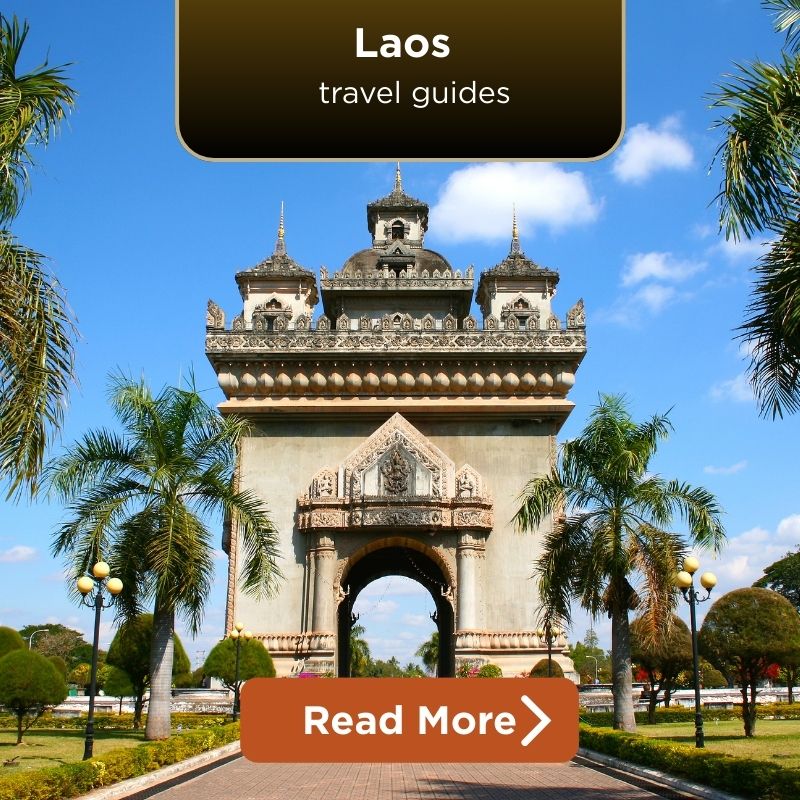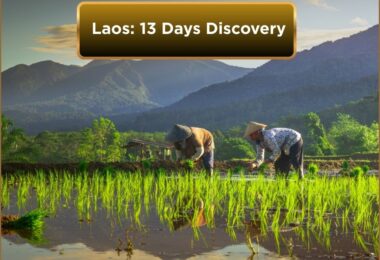Tam Mak Hoong – The Soul of Lao-Style Papaya Salad
Ask any local where to start with Lao food, and they’ll point you straight to Tam Mak Hoong — Laos’ answer to the green papaya salad, and arguably the most iconic lao salad there is.
This pounded salad begins with crunchy strips of green papaya, tossed with juicy tomatoes, fiery red chilies, garlic, lime juice, and — most importantly — padaek, the thick, funky fermented fish sauce that defines laotian cuisine. Unlike Thai som tam which uses clear fish sauce and sugar, the Lao version is earthier, bolder, and unapologetically fermented.
Prepared using the traditional mortar and pestle technique, this dish is all about balance: the sweetness of palm sugar, the acid of lime, the heat of chili, and the deep umami of padaek come together in an unforgettable explosion of flavor. It’s typically served with sticky rice and grilled chicken, but it shines all on its own.
Where to Try It
You’ll find Tam Mak Hoong throughout Laos, but for the best versions:
- Vientiane – The capital is home to legendary institutions like Kualao Restaurant, where you’ll find both classic and creative takes.
- Luang Prabang – Stroll through the Night Market and try it from local vendors who make it fresh to order.
- Pakse – Down south, Tam Mak Hoong often includes southern herbs and extra heat.
Ingredient Highlight – Padaek
A hallmark of Lao salad culture, padaek is no ordinary fish sauce. Made from freshwater fish from the Mekong, it’s fermented with rice bran and salt for up to a year, resulting in a thick, grainy paste loaded with umami depth. It’s not for the faint of heart, but once you acquire the taste, there’s no going back.
Suppose you’re intrigued by bold flavors and fermented ingredients. In that case, Tam Mak Hoong is the perfect gateway to understanding Hmong papaya salad, and the flavor logic of the entire Laotian cuisine tradition.
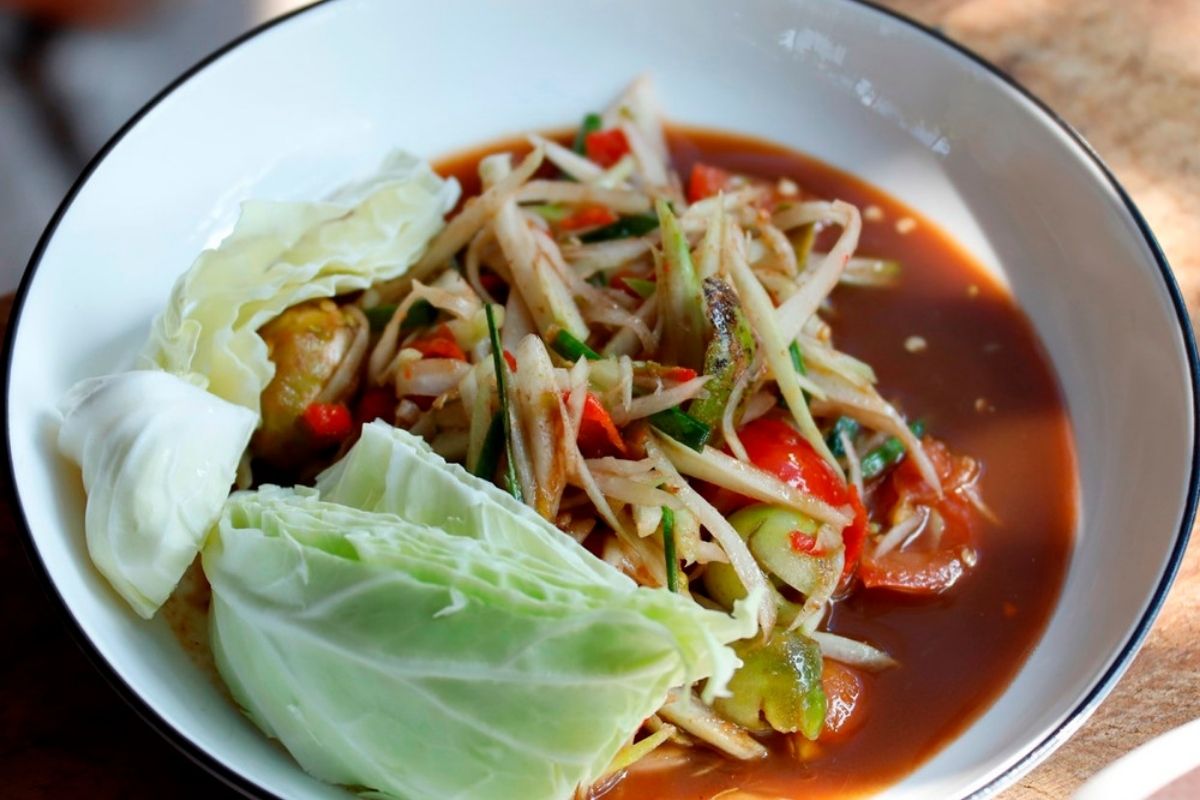
Tam Mak Hoong (Source: vietnamplus)
Larb – Laos Meat Salad Loved Across Regions
Next up on our flavor journey is Laos larb (sometimes spelled laap or laab) — a dish so central to Lao culture that it’s often referred to as the national dish. But make no mistake: this is no ordinary minced meat salad. This is Laos’ meat salad masterpiece — savory, zesty, and aromatic, all in one satisfying bite.
At its core, larb consists of finely minced meat — usually pork, chicken, duck, beef, or even fish — seasoned with lime juice, fish sauce, and an avalanche of fresh herbs like mint, cilantro, and scallions. But the real magic comes from khao khoua — finely ground, toasted sticky rice powder that adds a roasted aroma and signature texture.
Every region of Laos brings its own flair. In Luang Prabang, the dish leans into wild herbs. In Vientiane, the flavors are sharper and more acidic. Wherever you try it, expect a balance of sour, salty, herbal, and crunchy, with optional chili heat.
Best Places to Try
- Luang Prabang – Grab a table at Café Toui, a local favorite known for larb that’s both refined and deeply traditional.
- Vientiane – Head to Coconut Garden, where larb is made with both classic proteins and seasonal variations like mushroom or tofu.
Ingredient Spotlight
- Khao Khoua (Toasted Sticky Rice Powder) – Adds that essential smoky crunch that coats every bite with flavor.
- Culantro (Pak Tet) – Stronger and deeper than cilantro, culantro gives lao salad its unmistakable herbal backbone. Often confused with coriander, but far more potent, it elevates larb to new depths.
Whether you’re trying it with pork, duck, or fish, larb is a must-try for anyone serious about discovering laos meat salad at its finest. And trust us: once you taste it with freshly steamed sticky rice and a side of grilled eggplant dip, you’ll understand why this dish has traveled from humble village tables to global fame.
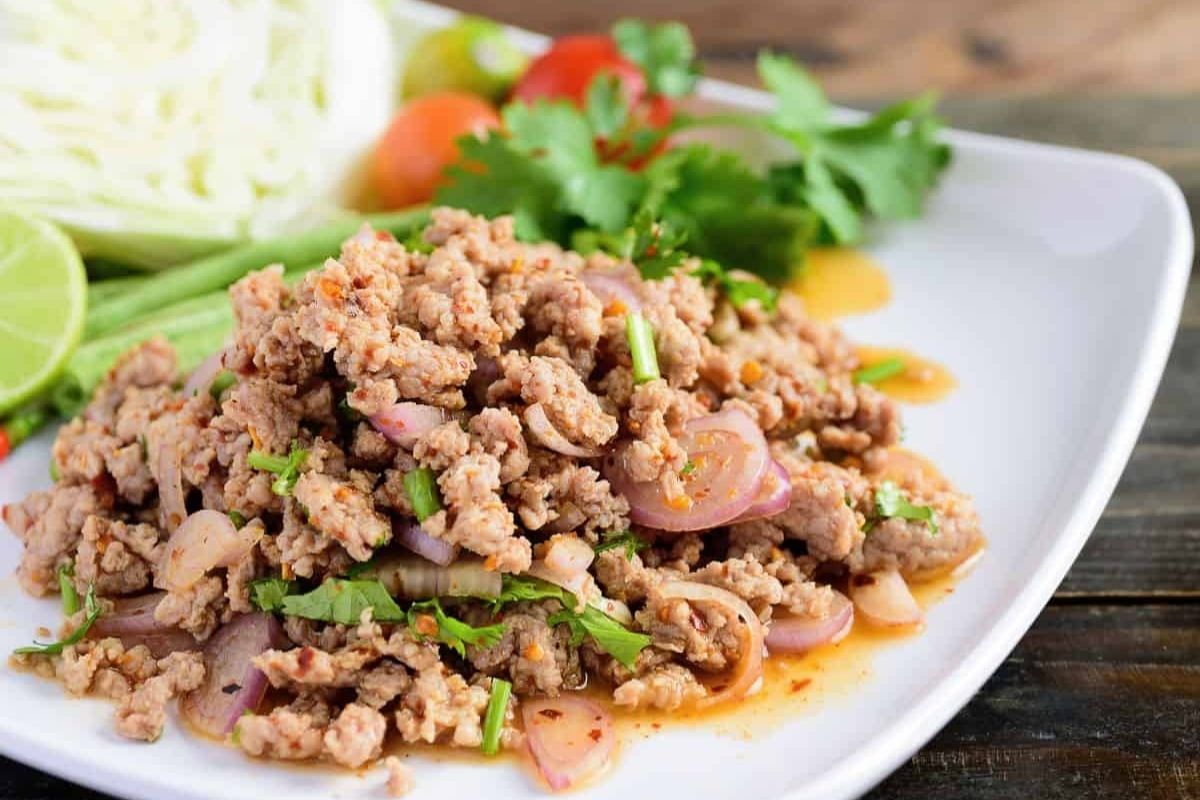
Larb (Source: hotthaikitchen)
Nam Khao – The Crunchy Rice Salad from Tha Deua
At first glance, this lao salad might seem unassuming. But one bite, and you’ll fall head over heels for its crackling rice texture, punchy herbs, and the zesty kick of sour pork. Nam Khao begins with deep-fried rice balls seasoned with red curry paste, lemongrass, and shallots. Once golden brown, these crispy orbs are crumbled by hand and mixed with crushed peanuts, fresh herbs, and bits of fermented sausage.
The secret? Eat it the Lao way — by wrapping spoonfuls of the salad into lettuce leaves with mint, chili, and lime. It’s a mouthful of spicy, crunchy, tangy joy.
Where It Comes From
- Origin: Tha Deua Village — where traditional families still fry their rice balls by wood fire.
- Best Spots to Try:
- Muzaik Restaurant in Vientiane for an elevated version.
- Street food stalls near the Vientiane riverside for the full local experience.
Ingredient Highlight – Wild Tree Shoots
Some of the most authentic Nam Khao plates in Laos feature wild tree shoots — seasonal forest greens collected by foragers. These are earthy, slightly bitter, and offer a wild aroma that no cultivated green can replicate. You won’t find this version outside the region, so savor it while you can.
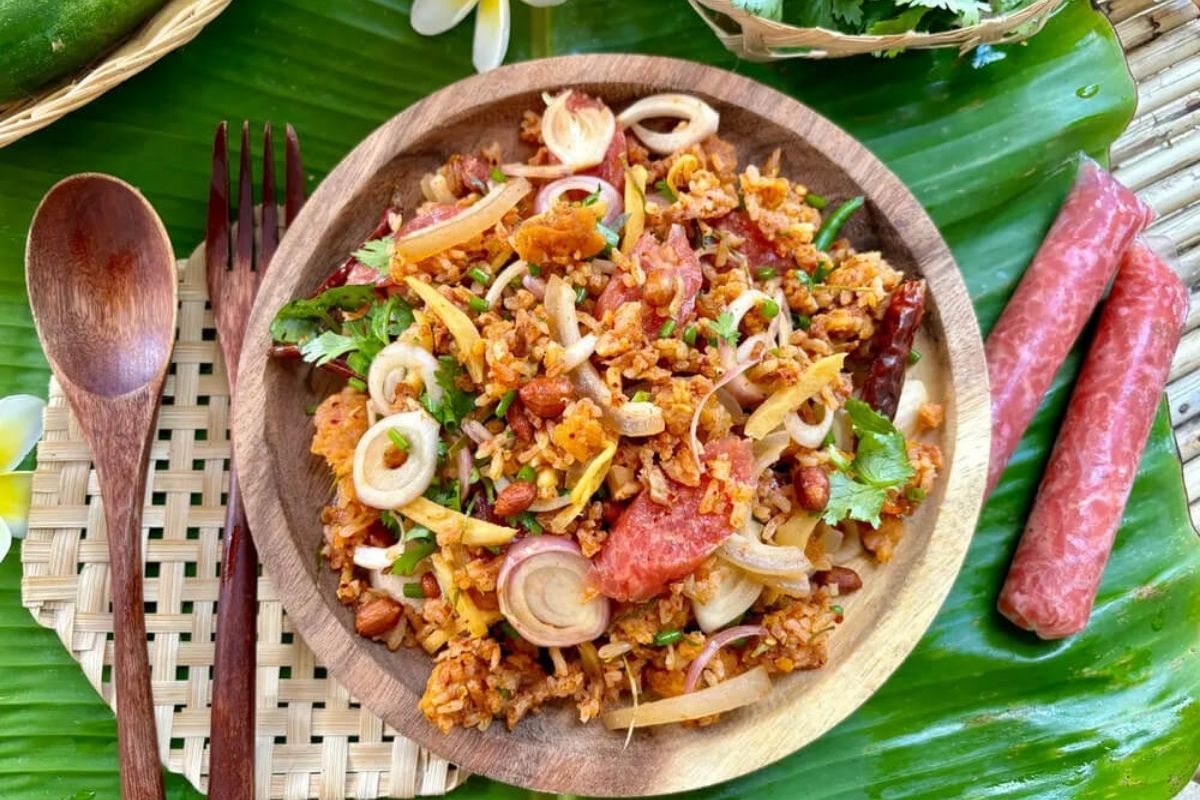
Nam Khao (Source: sakos)
Yum Salad – Creamy Egg Yolk Dressing Salad
Ready for something truly unexpected? Say hello to Yum Salad, a dish that takes everything you know about salad — and flips it on its head. Instead of light vinaigrettes, this Lao salad uses a rich egg yolk dressing blended with ground pork, fish sauce, sugar, and lime to coat crisp lettuce, cucumbers, tomatoes, and herbs.
It’s creamy. It’s sweet-savory. It’s utterly addictive.
Unlike other Laotian salads, Yum Salad isn’t built for heat — it’s built for balance and indulgence. You’ll often find it served in home kitchens, but in places like Luang Prabang, it’s also featured in stylish restaurants embracing modern Laotian cooking.
Where to Enjoy It
- Luang Prabang is the capital of Lao-French fusion, and you’ll find the best Yum Salad at:
- Manda de Laos – where the dressing is silky and made fresh daily.
- Local bistros and family kitchens across the Old Quarter.
Ingredient Highlights
- Tindora (Ivy Gourd): A tiny green gourd, crunchy with a gentle tang, often tossed raw into the salad for extra texture.
- Pumpkin Flowers: Used seasonally as a garnish or edible filling, these golden blossoms offer subtle floral sweetness and an artistic touch.
This dish also uses NatureSweet tomatoes, prized for their firmness and ability to hold up to the rich egg yolk sauce — making every bite pop.
So if you’re after something creamy, crisp, and uniquely Laotian, Yum Salad deserves a spot on your plate.
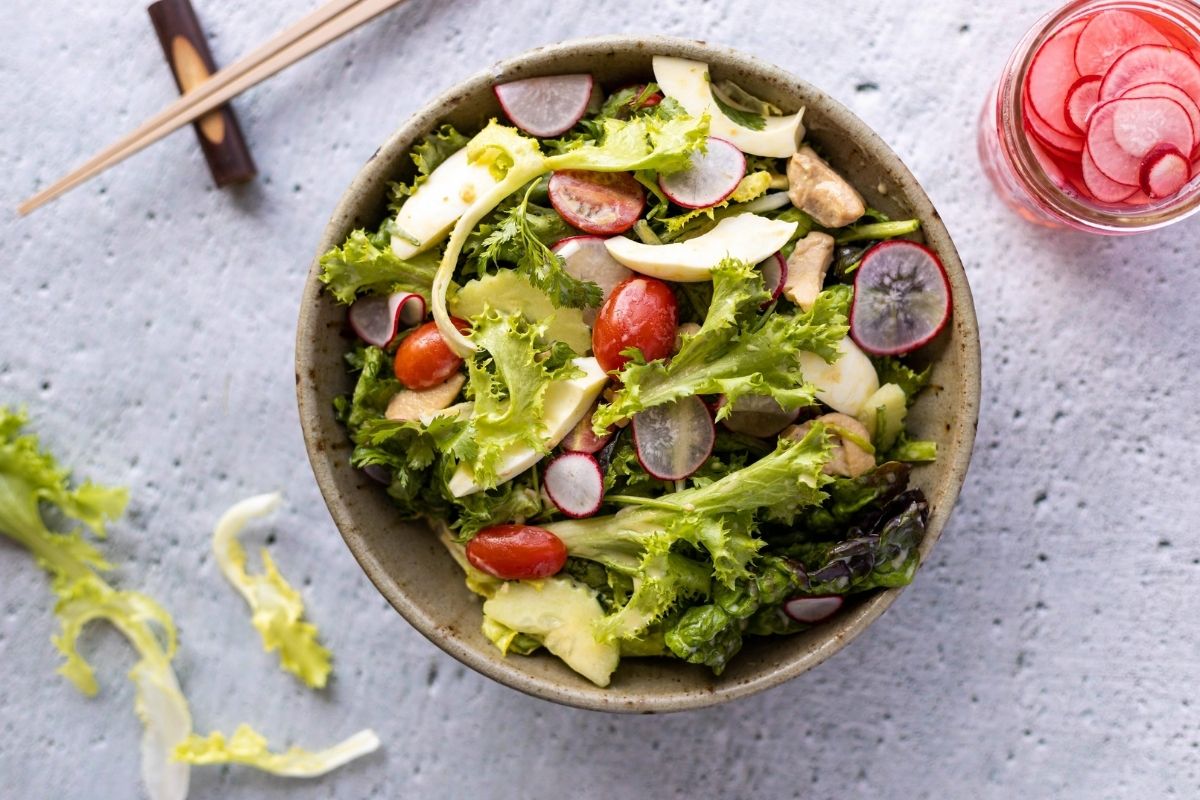
Yum Salad (Source: saengskitchen)
Luang Prabang Salad – French-Lao Harmony in a Bowl
Welcome to Luang Prabang, the former royal capital of Laos and home to a salad that perfectly captures the region’s Franco-Laotian heritage.
Luang Prabang Salad is elegant and refreshing — a fusion of French technique and Lao ingredients. Featuring fresh watercress, tomato, cucumber, and hard-boiled egg, this lao salad is lightly dressed in a vinaigrette or a creamy emulsion made from mashed egg yolk and oil.
Compared to its fiery cousins, this one is mild, delicate, and perfect for cooling the palate after a spicy feast. Its visual simplicity belies a depth of flavor drawn from local herbs and subtle seasonings.
Where to Find It
- Luang Prabang only — you won’t see this salad elsewhere in Laos.
- Must-visit spots:
- Tamarind – known for pairing this salad with traditional tasting menus.
- Manda de Laos – where it’s reimagined with gourmet finesse.
- Cooking classes around the Old Town – prepare your own under royal palms.
Ingredient Highlights
- Phak Ka Gnen (Rice Paddy Herb) – Citrus-like and aromatic, this rare herb brings a lift of mint and lemon grass all in one bite.
- Yanang Extract – A chlorophyll-rich green liquid used by chefs to add herbal freshness and slight thickness to vinaigrettes.
This salad is more than a dish — it’s a historical snapshot, bridging colonial influence with rural Lao ingenuity.
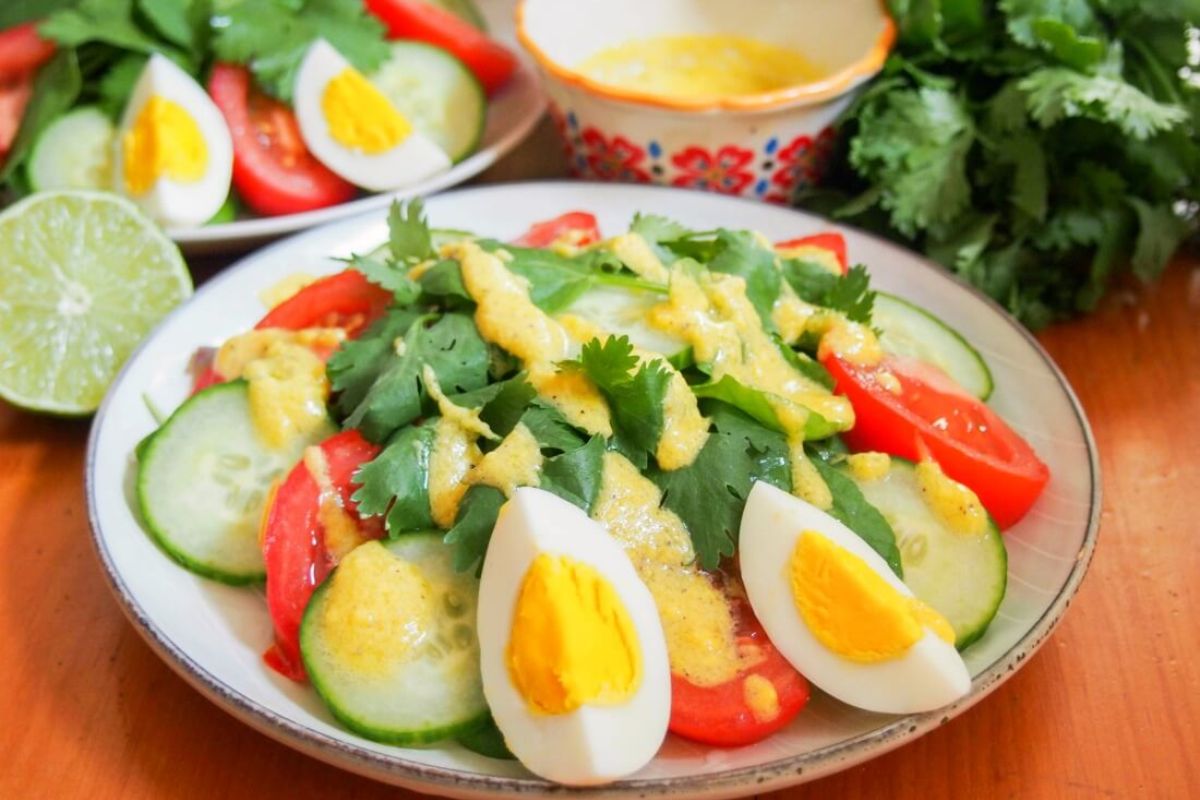
Luang Prabang Salad (Source: carolinescooking)
Comparative Table of 5 Lao Salads
|
Salad
|
Flavor
|
Texture
|
Best Place to Try
|
Rare Ingredient Highlight
|
|
Tam Mak Hoong
|
Spicy & sour
|
Crisp papaya, juicy tomato
|
Vientiane, Luang Prabang, Pakse
|
Padaek (fermented freshwater fish sauce)
|
|
Larb
|
Herby, tangy
|
Soft meat + crunchy rice
|
Luang Prabang, Vientiane
|
Khao Khoua (toasted rice), Culantro
|
|
Nam Khao
|
Crunchy, sour
|
Crispy rice flakes
|
Tha Deua Village, Vientiane
|
Wild Tree Shoots (foraged seasonal greens)
|
|
Yum Salad
|
Creamy, sweet-salty
|
Rich sauce + crisp veg
|
Luang Prabang
|
Tindora (ivy gourd), Pumpkin Flowers
|
|
Luang Prabang Salad
|
Mild, elegant
|
Balanced & refreshing
|
Luang Prabang only
|
Phak Ka Gnen, Yanang Extract
|
This table is your perfect companion for choosing which lao salad to try first — or all five if you’re on a full Impress Travel food tour.
Explore These Flavors with Impress Travel Laos Tours
Want to experience these authentic Lao salads exactly where they were born? Let Impress Travel Laos Tours craft your perfect culinary adventure:
- Walk through local markets in Vientiane and pick your own herbs before joining a cooking class.
- Sample Nam Khao with forest-picked tree shoots in its village of origin — Tha Deua.
- Taste Yum Salad and Luang Prabang Salad in riverside restaurants where history and modern Lao cuisine collide.
Whether you’re a foodie, a culture lover, or both, our market-to-table experiences give you not only the flavors, but the stories behind each dish.
FAQs About Lao Salads
How to say “papaya salad” in Lao?
The proper term is Tam Mak Hoong (ຕໍາໝາກຮຸ່ງ) — literally meaning “pounded papaya.” It’s one of the most widely eaten and loved dishes in the country.
Is Laos papaya salad healthy?
Absolutely. Traditional Lao salad recipes like Tam Mak Hoong are low in fat, high in fiber, and packed with vitamins A and C from green papaya and fresh herbs. However, some versions may include generous amounts of fermented ingredients like padaek, which can increase sodium levels.
Is papaya salad from Thai or Lao cuisine?
While papaya salad is found across Southeast Asia, its true origin lies in Laos, particularly the northeast Isaan region of Thailand, which shares deep cultural and culinary roots with Laos. The Thai version (Som Tam) is a modern evolution, but the technique and flavor philosophy remain distinctly Laotian.
X. Conclusion: Unlock the Secrets of Lao Cuisine with Every Bite
From the tangy crunch of Nam Khao to the rich, creamy depths of Yum Salad, each Lao salad carries a legacy of tradition, nature, and culinary craft. These dishes aren’t just sides — they are central expressions of Laotian identity, shaped by generations and flavored by forest, river, and field.
And with Impress Travel Laos Tours, your journey into this flavorful world becomes truly immersive. We don’t just serve the salad — we introduce you to the farmers, chefs, and culture behind it. This is more than a tour; it’s a connection to Laos through taste.


























